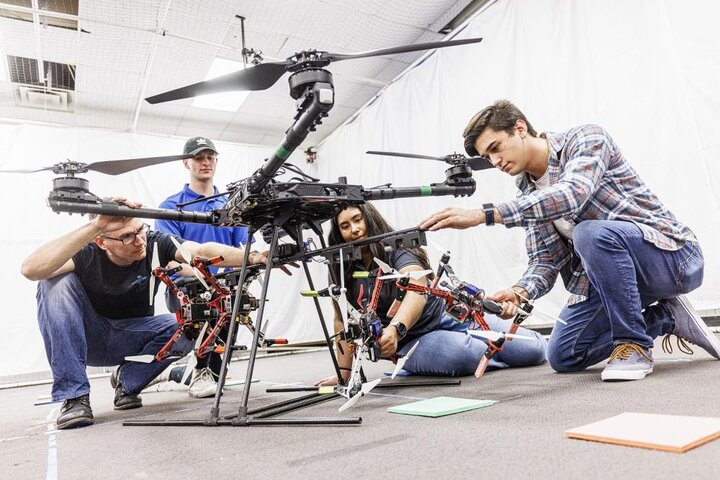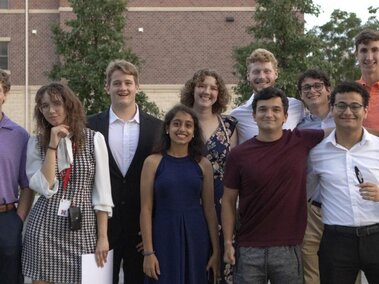REU Site: Undergraduate Research Opportunities in Unmanned Systems Foundations and Applications
Unmanned systems
Description

The REU site will provide undergraduates with a comprehensive research experience in the context of unmanned systems, a rapidly growing field of scientific and technological research. REU students will participate in carefully prepared research projects on unmanned systems with topics including unmanned aircraft system (UAS) vision-based control, behavior studies of robots in complex environments around humans, characterizing and developing vehicles for close environmental interaction, multi-agent unmanned aerial system design and control, and synergistic high resiliency communication. Research activities across the projects will be structured to provide a systematic research experience for the cohort, while enabling flexibility for each participant to focus on a particular area. The projects will be hosted at the University of Nebraska-Lincoln's Nebraska Intelligent MoBile Unmanned Systems Lab (UNL NIMBUS), which has mentored over 80 undergraduate students, and is a leader in aerial unmanned systems and their application to the environment.
See the list below for associated mentors and projects.
Want to know more?
Visit https://etap.nsf.gov/award/2278/opportunity/5612 to apply to this program.
Benefits
- Competitive stipend: $7,000
- Suite-style room and meal plan
- Travel expenses to and from Lincoln
- Campus parking and/or bus pass
- Full access to the Campus Recreation Center and campus library system
- Wireless internet access
Learn more about academic and financial benefits.
Events
- Department seminars and presentations
- Professional development workshops (e.g., applying to graduate school, taking the GRE)
- Welcome picnic
- Day trip to Omaha's Henry Doorly Zoo and Aquarium
- Outdoor adventures
- Research symposium
Questions about this program?
Please direct any questions related to this program to:
Justin Bradley: 402-472-5072 • justin.bradley@unl.edu
Assistant Professor > School of Computing
Dung Hoang Tran: 402-472-5029 • dtran30@unl.edu
Assistant Professor > School of Computing
Who Should Apply

Related Fields of Study
- Robotics
- Cyber-Physical Systems
- Human-Robot Interaction
- Formal Methods
Eligibility
Participation in the Nebraska Summer Research Program is limited to students who meet the following criteria:
- U.S. Citizen or Permanent Resident
- Current undergraduate with at least one semester of coursework remaining before obtaining a bachelor's degree
See Eligibility for more information.
How to apply
- This program has an alternative application.
- Submit the standard UNL SRP app only if you wish to be considered for additional SRP programs.
To apply for this program, please visit:
Mentors and Projects
| MENTORS | PROJECTS |
|---|---|
Dr. Justin BradleySCHOOL OF COMPUTING | Multi-agent UAS Design, Control, and Applications Unmanned, multi-agent systems can multiply the effectiveness of systems and significantly increase their individual capabilities through cooperation. However, multi-agent systems also present new challenges as failures can compound, and small inefficiencies are magnified. The NIMBUS lab has been developing an outdoor-based multiagent UAS testbed of 10-12 drones that can be used in a wide variety of multi-agent applications. The system is highly configurable, reliable, with an emphasis on enabling repeatability. Vehicles are identical, and Docker is used as a rapid deployment mechanism to ensure uniformity. REU students on this project will learn to improve upon our work in multi-agent control, decision-making, planning, or communication and test their improvements using the NIMBUS lab’s multi-agent testbed. Principles in centralized vs. decentralized algorithms will be the foundation and students will learn the hands-on skills to maintain, deploy, and conduct field experiments with multi-agent robotic systems. |
Dr. Justin Bradley and Dr. Brittany DuncanSCHOOL OF COMPUTING | Close interactions of UAS with the environment Current UAS are able to collect large amounts of data for scientists by flying high and taking pictures. The next generation of drones will be able to do more by directly interacting with the environment. The NIMBUS Lab is leading a collaborative effort to develop the next generation of drone algorithms and systems to enable close interaction with a rain-forest environment. Rain-forest canopies are important ecosystems for diverse plant and animal life, however, validating the model-based predictions for scientific decisions about these environments is difficult due to a lack of efficient data collection methods. We are developing an UAS-based leaf cutting system that will allow scientists to collect leaf samples from the canopy without putting people at risk or disturbing sensitive portions of the environment. The system will be able to collect leaf samples from the top of the canopy and also from within the canopy while maintaining a safe distance between the tree and the UAS. Students on this project will work on an interdisciplinary team where they will learn about and build on NIMBUS Lab research the sensors, electro-mechanical systems, and algorithms needed to operate near and interact with the environment with a UAS. After initial design, they will iteratively improve the approach through lab testing and simulation before moving to outdoor tests and field experiments. Students will have the opportunity to participate in local field trials with the larger team to learn how to collaborate with and present research to a larger interdisciplinary research team. |
Dr. Brittany DuncanSCHOOL OF COMPUTING | Development of Proficiency with Robotic Systems across Users, Domains, and Applications Achieving a goal of integrative, heterogeneous, multi-robot systems for environmental sensing and deployment by non-roboticists will require systems that can perceive and adapt to the user’s skill level and work collaboratively to help them achieve their goals. This project will seek to understand user proficiency across aerial, water surface, and underwater platforms used for monitoring beaver activity. The study of expertise and proficiency can help us understand the learning and knowledge acquisition processes to inform better instruction and training methods. The definition and classification of expertise, however, can vary depending on the field and further research is needed in knowledge and reasoning processes to understand the qualities of expertise in a given context. We will build on previous work to adapt to users while observing nominal operation to better understand user requirements for integrative robotics systems that they can deploy to collect complementary samples for their fieldwork. Students working on this project will be taught to run human subjects studies; add additional sensing capabilities to the unmanned system; and have completed ethnographic observations designed to hypothesize about the research described above. |
Dr. Shuai NieSCHOOL OF COMPUTING | Synergistic Communications with High Resiliency High-throughput wireless communications rely on available spectrum resources to provide wide bandwidth. Equipping the UAS with advanced communication capabilities will benefit data transfer between ground infrastructure and drones in many scenarios, ranging from fire and rescue to providing coverage for users not accessible with traditional cellular networks. Current fifth-generation (5G) networks adopt millimeter-wave (mmWave) spectrum as part of the key technology to enable multi-giga-bits-per-second (Gbps) end-to-end links. However, mmWave is known to have much higher free-space path loss as compared with its counterpart in the microwave frequency, thus necessitates the use of phased antenna arrays to generate beams with high gains and compensate for the path loss. As the agents in a UAS team move in the air, the dynamic position leads to the issue of beam misalignment, which needs constant corrections in antenna array patterns in a timely manner to maintain a stable link. Novel algorithm design on beam realignment, based on our prior research, will enable a resilient design in UAS communications at mmWave bands. Students will learn to design adaptive beamforming algorithms. They will also gain the first-hand experience incorporating the designed algorithms in a radio propagation simulation testbed. Students will be trained to use our developed ray-based three-dimensional mmWave radio propagation simulator called “RuralProp” that emulates a UNL research farm field. They will be guided to design beamforming algorithms capturing the features of UAS motion. Finally, students will experimentally validate their developed algorithms in real-world environments using the NIMBUS lab multi-agent testbed. |
Dr. Dung-Hoang TranSCHOOL OF COMPUTING | Vision-based Control for Collaborative Autonomous Robots Many safety-critical applications, such as wildfire management, surveillance, and rescue in natural disasters, and nuclear power plant monitoring and maintenance, require the precise collaboration of heterogeneous multiple mobile robots operating under dangerous and intense conditions. In this context, precise control of air/ground robots under environmental uncertainties such as strong wind and GPS-based localization errors is critical to optimize their utilization and energy consumption while preserving their safety. The NIMBUS Lab has pioneered the use of UAS in fire monitoring and ignition, but UASs are not being leveraged to collaborate with ground vehicles for a wider range of applications. Students on this project will investigate real-time object detection using machine learning (ML) and vision-based landing control for a UAS on a Husky robot using supervised/reinforcement learning. Activities will include the collecting of data for training the real-time object recognition module and landing controller; training and testing these ML models on a drone and the Husky robot; performing a literature review on existing approaches and algorithms that may be applicable; designing and performing field studies to assess their creation; and a report and poster capturing all the activities performed and results obtained. |
Funding
Funding for this research program was generously provided by grants from:
NSF - National Science Foundation
FUNDING SOURCE:
